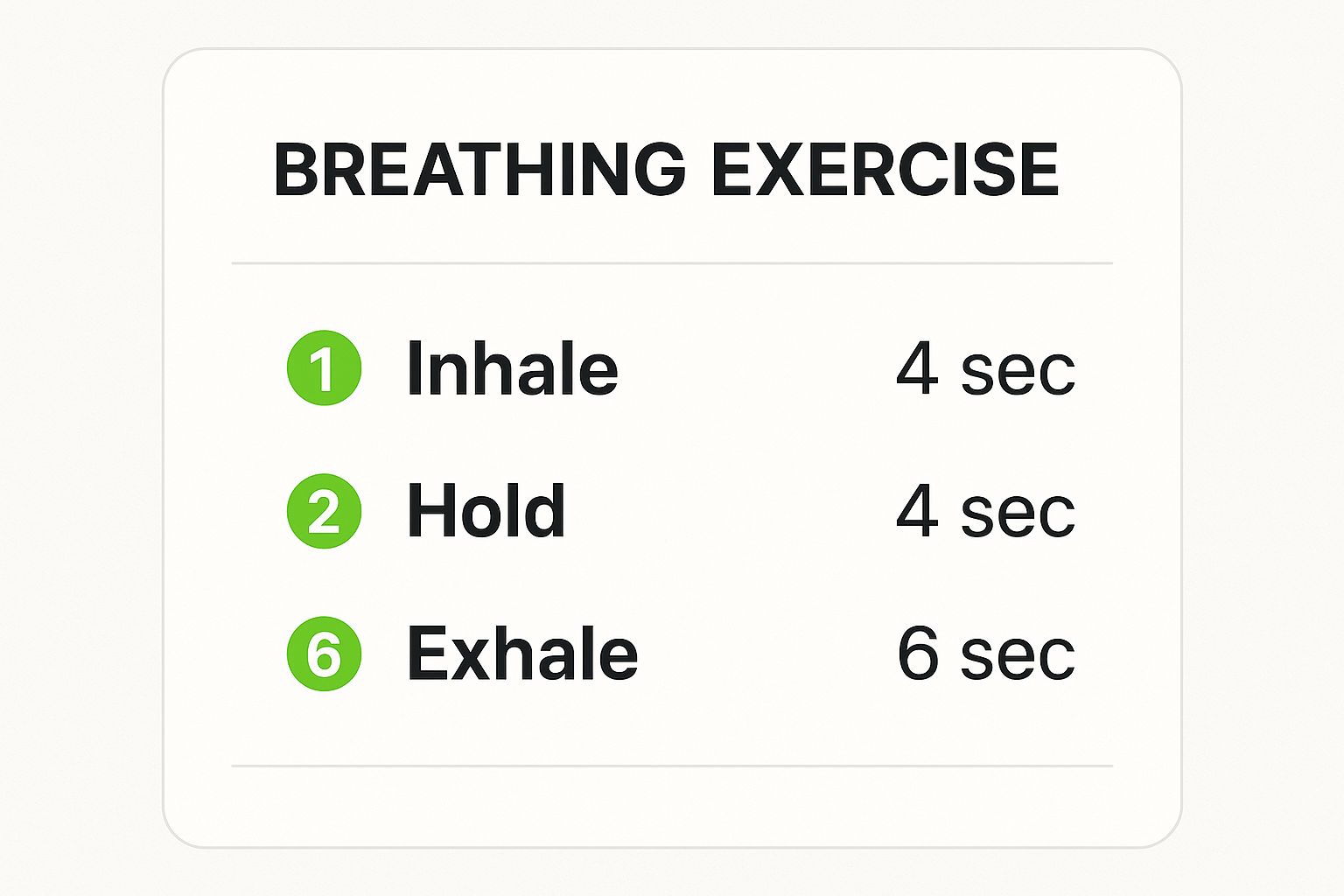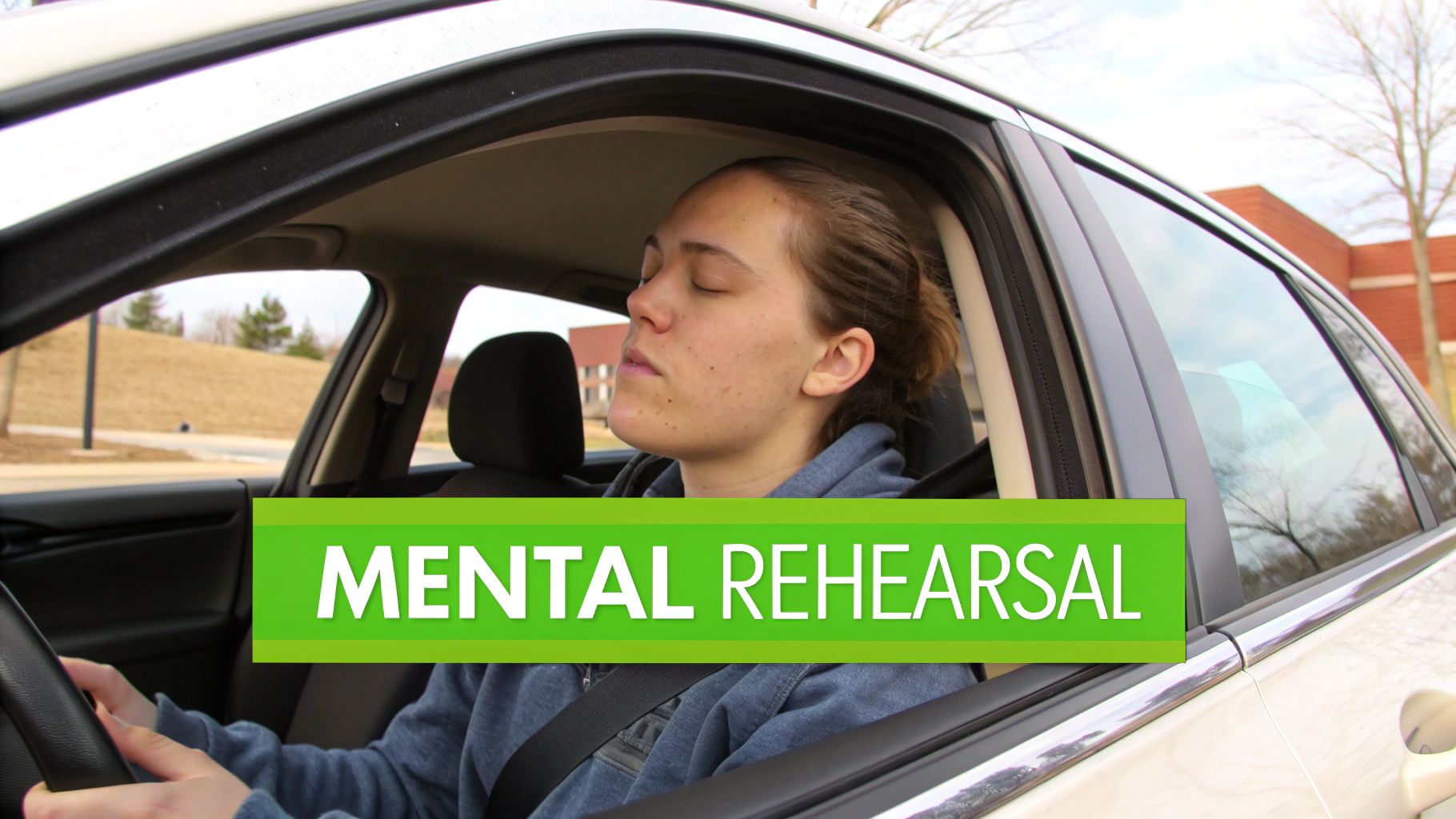Why Your Driving Test Nerves Are Completely Normal

It's perfectly natural to feel anxious about your driving test. Almost everyone experiences pre-test jitters. This isn't a sign of weakness, but a normal reaction to a high-pressure situation. It simply means your brain is recognizing the importance of the event. If you're feeling particularly nervous, you may find some helpful advice in this article: How to master driving lessons for nervous drivers.
Understanding the Psychology of Test Anxiety
Test anxiety comes from a mix of factors, including the pressure to perform and the fear of disappointing yourself or others. The current backlog of learners also adds to the stress. As of January 2025, there were 580,067 forward bookings for practical driving tests, almost triple the pre-pandemic numbers.
This backlog means longer wait times, with three-quarters of UK driving test centers operating at full capacity. The added pressure of waiting, combined with the current pass rate of around 48.9%, can significantly increase anxiety. For a deeper dive into these statistics, see: Driving Tests Backlog and Pass Rates.
Your Body's Natural Response to Stress
Your body responds to stress by releasing hormones like adrenaline and cortisol. These hormones can cause physical symptoms, such as a racing heart, sweaty palms, and that familiar feeling of butterflies in your stomach. Rather than viewing these symptoms as negative, recognize them as your body preparing you for the challenge. For example, an increased heart rate delivers more oxygen to your brain, improving alertness and reaction time.
Normalizing Your Feelings Is the First Step
Accepting these feelings as a normal part of the driving test experience is crucial for managing them effectively. Instead of trying to suppress your nerves, learn to work with them. Acknowledging your anxiety is the first step towards a calmer and more confident approach to the test. This acceptance allows you to focus on practical relaxation techniques to further manage your pre-test nerves.
Physical Techniques That Actually Calm Your Body
Your body often holds tension, sometimes without you even realizing it. Learning to release this tension can significantly improve your driving test performance. Here are some proven physical relaxation methods that are especially helpful in pre-test situations.
Progressive Muscle Relaxation
Progressive muscle relaxation involves systematically tensing and releasing different muscle groups, starting with your toes and working upward to your head. This technique creates a wave of calm throughout your body. It's like a targeted release of pent-up energy, leaving you feeling more relaxed and centered.
- Start with your toes: tense them for 5 seconds, then release.
- Move to your feet, calves, thighs, and so on, repeating the tensing and releasing process.
- Notice the contrast between the tension and relaxation in each muscle group.
This exercise helps you become more aware of where you hold tension and provides a direct method for releasing it.
The 4-7-8 Breathing Technique
The 4-7-8 breathing method is a powerful way to activate your parasympathetic nervous system, triggering your body's natural relaxation response. This technique is simple yet remarkably effective:
- Inhale deeply through your nose for a count of 4.
- Hold your breath for a count of 7.
- Exhale slowly through your mouth for a count of 8.

This infographic illustrates the 4-7-8 breathing pattern: inhale for 4 seconds, hold for 7 seconds, and exhale for 8 seconds. Following this rhythmic breathing effectively slows your heart rate and promotes a sense of calm. It's a quick and easy way to regain control over your nervous system.
Stretches and Pressure Points
Simple stretches performed in the test center car park can also make a difference. No need for complex yoga poses; gentle neck rolls, shoulder shrugs, and back stretches can release built-up muscle tension. Applying pressure to specific pressure points, such as the fleshy area between your thumb and index finger (known as the Hegu point in acupressure), can offer additional relief.
Posture and Hand Placement
Your physical posture can influence your mental state. Sitting upright with relaxed shoulders projects confidence, both to yourself and the examiner. Paying attention to your hand placement on the steering wheel is equally important. A relaxed grip conveys a sense of control and composure, essential for a successful driving test.
To help you choose the best technique for your needs before your test, here is a quick comparison of the techniques we've covered:
Quick Physical Relaxation Techniques Comparison
| Technique | Duration | Effectiveness | Best Time to Use | Difficulty Level |
|---|---|---|---|---|
| Progressive Muscle Relaxation | 10-15 minutes | High | Before the test or during breaks | Easy |
| 4-7-8 Breathing Technique | 1-5 minutes | High | Before the test, in the car park, or during the test if needed | Easy |
| Stretches and Pressure Points | 5-10 minutes | Medium | Before the test or in the car park | Easy |
| Posture and Hand Placement | Continuous | Medium | During the test | Easy |
These physical techniques, practiced regularly, become valuable tools for managing test-day nerves. Combining physical relaxation with mental preparation will significantly boost your chances of passing your driving test.
Mental Preparation That Builds Unshakeable Confidence

Your mindset plays a crucial role in your driving test performance. This section explores effective mental strategies that can help cultivate genuine confidence. These techniques emphasize preparing your mind for success, rather than dwelling on the possibility of failure. This means shifting your focus from potential mistakes to showcasing your driving proficiency.
Visualization: Mentally Rehearsing Success
Visualization involves mentally practicing your driving test from start to finish. Imagine arriving at the test center, going through the various stages, and completing the final maneuver. This mental rehearsal creates neural pathways, making success feel more familiar and achievable. By visualizing each step, from adjusting your mirrors to executing a smooth parallel park, you're effectively pre-programming your brain for a positive outcome.
- Imagine yourself confidently completing each part of the test.
- Focus on the feeling of smoothly navigating through traffic.
- Visualize successfully handling various road conditions and maneuvers.
This mental preparation reduces anxiety by creating a sense of familiarity and control, allowing you to approach the test with greater confidence.
Positive Self-Talk: Replacing Limiting Beliefs
Negative thoughts can significantly impact your performance. Positive self-talk is a powerful tool to counteract these self-defeating thoughts. Replace negative statements like "I'm going to fail" with positive affirmations such as "I've prepared well, and I'm ready to succeed."
- Create personalized affirmations that resonate with you.
- Repeat these affirmations regularly, particularly in the days leading up to your test.
- Reflect on your strengths and past successes to reinforce your confidence.
Consistent positive self-talk strengthens your belief in your abilities and promotes a more positive outlook on the test. You might be interested in: How to pass your driving test first time.
Mental Anchors: Triggering Calm and Focus
Mental anchors are specific words, phrases, or physical actions that evoke a sense of calm and focus. These anchors can be used during stressful moments to regain control and composure.
- Choose a word, phrase, or gesture that has positive connotations for you.
- Associate this anchor with a feeling of calm and confidence.
- Activate your anchor whenever you feel overwhelmed or anxious.
This technique provides a readily available tool to manage stress and maintain focus throughout your driving test.
Reframing the Test: An Opportunity, Not a Threat
Instead of viewing the driving test as a potential failure, reframe it as an opportunity to showcase your driving skills. This shift in perspective changes the test from a source of anxiety to a welcome challenge.
- Focus on demonstrating your skills and knowledge to the examiner.
- View the examiner as a guide, there to assess your abilities.
- Embrace the opportunity to showcase your driving proficiency.
This positive reframing reduces pressure and allows you to perform at your best. By incorporating these mental strategies and practicing physical relaxation techniques, you'll be well-prepared to manage your nerves and confidently approach your driving test.
The Night Before: Setting Up Your Success Foundation
The evening before your driving test is critical. A calm and organized approach can significantly impact your performance. This involves getting a good night's rest, preparing necessary items, and avoiding anxiety-inducing activities. This section offers a guide for a successful pre-test evening.
The Ideal Pre-Test Dinner
Your dinner choice can affect your sleep and anxiety. Choose a meal with complex carbohydrates and lean protein for sustained energy and stable blood sugar. Avoid sugary foods and caffeine, as these can disrupt sleep and heighten anxiety. Grilled chicken with brown rice and vegetables is an excellent option. This provides sustained energy without causing a sugar crash or sleeplessness, setting a positive tone for the evening.
Sleep Optimization Techniques
Adequate sleep is vital for optimal performance. Create a relaxing bedtime routine to prepare your mind for rest. This could involve a warm bath, reading, or listening to calming music. Avoid screens for at least an hour before bed, as the blue light from electronic devices can interfere with sleep. This routine will help you achieve a restful night's sleep, ensuring you awaken refreshed and alert.
Preparation: Everything in Its Place
Organizing everything you need the next day minimizes morning stress. Consult our guide on preparing for your driving test. Gather your provisional license, theory test pass certificate, and other necessary documents. Choose comfortable, confidence-boosting clothing and lay it out. This preparation eliminates last-minute rushes, allowing you to begin your test day feeling calm and collected.
Things to Avoid: Cramming and Social Media
Avoid cramming the night before. Excessive review of the Highway Code can increase anxiety rather than improve knowledge. Stay off social media; comparing yourself to others can fuel self-doubt. Instead, focus on relaxation and positive self-talk. This protects your mental well-being and keeps you focused on your preparation. Prioritizing restful sleep and thorough preparation creates a strong foundation for test-day success. This allows you to approach the test with confidence and composure, knowing you've done everything you can to prepare.
Morning Routine for Test Day Confidence

The morning of your driving test presents a final opportunity to prepare. A structured routine can significantly lessen stress and boost your confidence. The goal isn't to achieve an unrealistic ideal, but rather to feel as prepared and in control as you possibly can. This starts with properly fueling your body and mind.
Brain-Fueling Breakfast: Start Your Day Right
A balanced breakfast is essential for maintaining energy and focus throughout the morning. Choose a meal that combines slow-releasing carbohydrates, protein, and healthy fats. Good options include porridge with berries and nuts, or scrambled eggs with wholemeal toast. These choices provide sustained energy, preventing energy crashes that can negatively impact concentration and mood. Avoid sugary cereals or pastries, as these can lead to energy dips right when you need to be at your best.
The Ideal Pre-Test Timeline
A well-paced morning routine minimizes the chance of feeling rushed or overwhelmed. Wake up with plenty of time for breakfast, relaxation exercises, and travel to the test centre. Aim to arrive at the test centre approximately 15-20 minutes early. This buffer allows for unforeseen delays and gives you a few moments to compose yourself. Rushing can heighten anxiety, while a calm, planned approach sets a positive tone for the entire test.
Coordination Warm-Up: Connecting Mind and Body
Simple warm-up exercises can improve coordination and enhance your sense of control behind the wheel. These don't need to be strenuous. Gentle stretches, neck rolls, and even a short walk can help you feel more connected to your body and reduce tension. This physical grounding can significantly impact your mental state, promoting a sense of calm and readiness. Think of it like a musician warming up their fingers before a performance – these exercises prepare both body and mind.
Managing Last-Minute Nerves: Quick Reset Techniques
Even with thorough preparation, some pre-test jitters are perfectly normal. Having quick reset techniques can help manage these feelings. Deep breathing exercises, like the 4-7-8 method, can quickly calm your nervous system. You might also consider positive self-talk or mental anchors to reinforce your confidence and regain focus. These techniques offer immediate relief from anxiety, helping you maintain composure before the test. Interestingly, the Driver and Vehicle Standards Agency (DVSA) reported that in March 2025, the pass rate rose to 49.0% from 46.9% the previous year, even with fewer tests conducted. This suggests learners are prioritizing better preparation. More detailed statistics are available here: UK Driving Test Data. Focusing on your personal readiness is key.
Productive Waiting: Final Moments of Calm
The time spent waiting at the test centre can be used productively to maintain a calm and focused mindset. Mentally review key driving concepts, practice deep breathing, or simply observe your surroundings without judgment. Avoid conversations that might increase your anxiety. This time is for solidifying your preparation and building your confidence. By using these waiting moments wisely, you'll enter the test feeling composed and ready to succeed.
Staying Calm When the Test Actually Begins
Once you're in the car with the examiner, managing your stress in real-time becomes crucial. This section offers practical techniques to help you maintain composure throughout your UK driving test. These strategies are designed to help you demonstrate your true driving abilities, even under pressure. They're not just about managing stress; they're about optimizing your performance.
Breathing Techniques For In-Test Calm
You can use specific breathing exercises while driving without losing focus. For example, the 4-7-8 method can be adapted for use during your test. Instead of audible exhales, concentrate on the rhythm of your breathing. A quick inhale for a count of 4, hold for 7, and a slow, controlled exhale for 8 can calm your nerves without diverting your attention from the road. This discreet technique can be practiced at traffic lights or during other short pauses.
Recovering From Minor Mistakes
Even experienced drivers make occasional mistakes. The key is to avoid letting a minor slip-up ruin your entire test. Acknowledge the mistake and immediately refocus on the task at hand. Dwelling on past errors will only increase anxiety and negatively impact your subsequent performance. Treat each moment as a new beginning. If you stall, for example, take a deep breath, restart the car calmly, and continue driving as smoothly as possible. This shows resilience and control.
Effective Communication With The Examiner
Think of the examiner as a guide, not an adversary. Their job is to evaluate your driving skills, not to intimidate you. Clear communication can significantly reduce stress. If you're unsure about a direction, politely ask for clarification. This demonstrates proactive communication and ensures you understand the instructions correctly. If you make a mistake, briefly acknowledge it and move on. The examiner is evaluating your ability to recover and stay composed.
Handling Unexpected Challenges
Unexpected situations like traffic jams, adverse weather conditions, or challenging maneuvers can be stressful during a driving test. While preparation is essential, adaptability is equally important. Mentally rehearsing how you’d handle these situations can boost your confidence. Visualize yourself calmly navigating heavy traffic or adjusting your driving in rainy conditions. Remember your training and apply the relevant techniques. This proactive mental preparation will help you remain calm and focused, even when faced with the unexpected.
The following table offers a quick reference for managing stress during different phases of your driving test.
| Test Phase | Common Stressors | Quick Calm Technique | Recovery Time |
|---|---|---|---|
| Manoeuvres | Stalling, forgetting the sequence | 4-7-8 breathing, positive self-talk | Immediate |
| Independent Driving | Unfamiliar routes, complex junctions | Deep breaths, visualize the route | 1-2 minutes |
| Show Me, Tell Me | Forgetting answers, feeling rushed | Pause, take a breath, recall the information | 30 seconds |
| General Driving | Heavy traffic, unexpected hazards | Adjust speed, maintain safe following distance, 4-7-8 breathing | Ongoing |
By using these techniques, you can maintain composure and showcase your driving skills effectively. This will help you perform at your best on the day of your test.
Building Lasting Confidence Beyond Test Day
While immediate relaxation techniques can be helpful for managing test-day jitters, genuine driving confidence comes from thorough preparation and consistent practice. This long-term approach lessens your dependence on last-minute stress management and equips you with the skills and mindset necessary for a lifetime of safe driving. It's similar to learning to ride a bicycle: initial wobbles are unavoidable, but regular practice builds balance and control.
Working Effectively With Your Driving Instructor
Your driving instructor is an invaluable asset. Several weeks before your test, collaborate with them to identify and systematically address any areas where you feel less confident. This might involve focused practice on specific maneuvers, like parallel parking or navigating roundabouts. This targeted practice is much more effective than simply accumulating hours behind the wheel. For instance, if hill starts are a challenge, dedicate extra sessions to perfecting this skill until it becomes automatic.
Mock Test Strategies: Simulating the Real Thing
Mock tests are essential for building confidence. These simulated exams recreate the structure and conditions of the actual driving test, allowing you to familiarize yourself with the procedures and expectations. This reduces the uncertainty of the test day and allows you to concentrate on showcasing your skills, instead of dealing with unfamiliar situations. Furthermore, mock tests offer valuable feedback on your performance, pinpointing both your strengths and areas for improvement. This personalized evaluation allows you to refine your skills and bolster your confidence in your abilities.
Resilience-Building: Bouncing Back From Setbacks
A key characteristic of a confident driver is the ability to recover swiftly from mistakes. Resilience isn't about avoiding errors entirely; it's about how you react to them. During practice sessions, intentionally place yourself in challenging circumstances, such as driving in heavy traffic or handling unexpected hazards. Practice regaining your composure and focus after minor errors. This strengthens your capacity to remain calm and attentive under pressure, a skill crucial not just for passing the test, but for handling real-world driving situations. This way, even if a minor mistake occurs on test day, you'll possess the mental strength to recover quickly and maintain your composure.
Transforming Nervous Energy: From Anxiety to Focus
Nervous energy isn't inherently negative; it's simply energy awaiting proper direction. Instead of perceiving pre-test jitters as a sign of weakness, reframe them as a source of heightened alertness and concentration. This shift in perspective allows you to harness that energy to enhance your performance, rather than letting it become overwhelming. Much like an athlete preparing for a competition, you can use this energy to sharpen your senses and quicken your reaction time.
Skills-Based Confidence: The Foundation of Success
True confidence originates from competence. Concentrating on developing a solid foundation of driving skills is much more beneficial than relying solely on techniques for stress management. When you are confident in your ability to handle a vehicle, your self-assurance naturally increases. Passing your driving test then becomes a natural outcome of your preparation, not a matter of chance. This approach not only eases pre-test anxiety but also prepares you for a lifetime of safe and confident driving.
Ready to accelerate your driving journey and pass your test with confidence? Fast Pass Driving Courses offers intensive and semi-intensive driving lessons throughout the UK, designed to get you test-ready quickly. Visit us to learn more and book your course.

